The Ultimate Guide to Conducting Customer Surveys in 2024
Learn everything there is to know about conducting customer surveys and find out you can use customer survey results to offer a holistic customer experience



What’s the secret to building a successful business? Two words: satisfied customers. 88% of buyers say experience matters as much as a company's products or services.
The best way to offer a positive customer experience is to understand what your customers really want, and that’s where customer satisfaction surveys come into play.
Conducting customer surveys isn’t just about mass emailing your customers a link to a survey and calling it a day.
It’s about crafting an intricate list of questions that give you actionable insights on how you can improve your products, reduce churn, and build a loyal customer base.
In this blog, we tell you the A-Z of conducting a customer satisfaction survey and how you can use survey results to become a customer-centric company.
What are customer surveys?
A customer survey is a questionnaire that brands send to ask what customers think about their products or services, brand, or other interactions with their business. The goal is to obtain and use feedback from customers to improve your product.
Customer surveys are the most direct way to collect constructive feedback from people who know the strengths and weaknesses of your products and services.
A good product paired with a good customer experience is the key to driving revenue. Remember that 52% of customers switch to a competitor after a negative experience.
If you want to avoid losing customers and revenue, you must survey your customers to uncover what they really want and resolve their needs in the right way.
How does CSAT work?
Customer Satisfaction Score or CSAT allows you to gauge your customers' satisfaction level. You can effortlessly track and monitor customers’ experiences after a particular transaction or at touchpoints like post-purchase, post-delivery, or after interacting with a customer support agent.
CSAT measures customer satisfaction by asking simple questions like 'How satisfied were you with your experience?' Rate your experience from 1 – 10.”

Why measure customer satisfaction constantly?
73% of consumers will switch to a competitor after a bad experience. If you are unaware of your customers' concerns and fail to resolve them, you risk customer churn and potential revenue from future customers.
“If you can’t measure it, you can’t fix it. If you care about customer satisfaction, I think you need the right mechanisms to measure customer satisfaction to get accurate data,” Derek Brown, Founder and CEO of Pronto Marketing.
Customer surveys are your CX team’s sidekick in uncovering how they can best improve their products and provide positive experiences for their buyers.
How to gather useful, constant customer feedback?
Getting feedback is just one piece of the puzzle. The main goal is to get accurate and honest customer feedback that you can actually use. Send out surveys you feel are apt for your category and industry.
According to research, 64% of consumers appreciate when a brand seeks their feedback or opinions in a survey. But they’d want to answer relevant questions about optimizing customer experience.
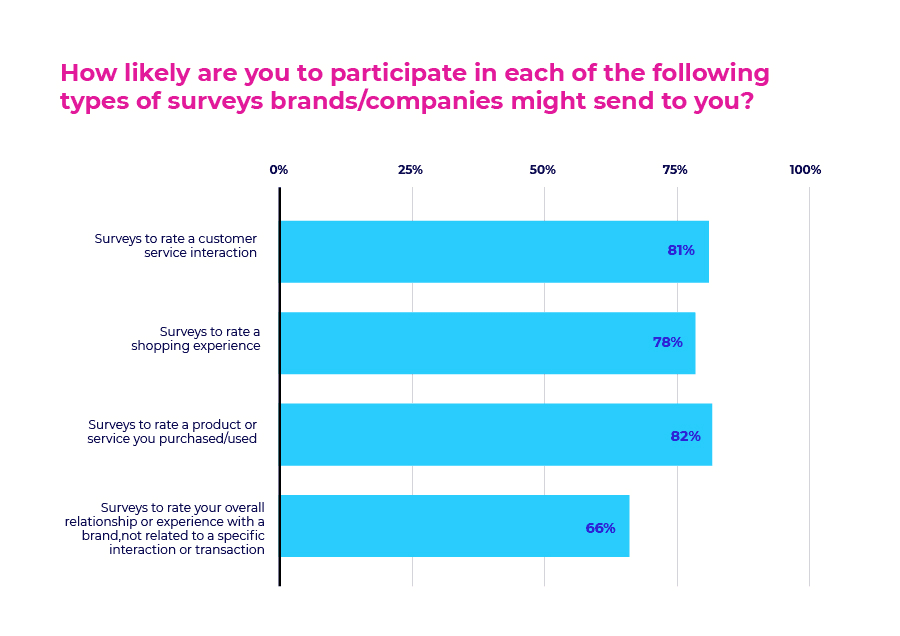
Source: Khoros
Here are a few tips on gathering helpful and direct feedback from customers:
Send out feedback forms via multiple channels
Monitor social media
Embed surveys on websites via live chat
Create an online community
12 Best practices for customer satisfaction surveys
Creating effective surveys requires thoughtful consideration of various factors to ensure meaningful and actionable insights.
Here are 12 best practices you can follow to create customer satisfaction surveys that strengthen customer relationships and drive overall business improvement:
Ask the right person
If you’re building a tool for marketers, you shouldn’t send out customer surveys to lawyers. Make sure you ask the right audience for feedback to get a proper insight into how you can get more satisfied customers,
The single best attribute to qualify somebody as your target is somebody who already interacted with your brand. This could be post-purchase or ones who dropped off before making a purchase.
Keep it clear and concise
Customers get many surveys from brands and don’t have the time to fill them all. Keep your surveys short to avoid survey fatigue and prioritize questions directly contributing to your objectives.
A shorter, more focused survey will likely be completed, leading to higher response rates and more accurate data.
Ensure that the survey questions are easy to understand. Avoid technical terms or jargon that may be unclear to your audience or lead to confusion or misinterpretation.
Send your survey at the right time
Timing is everything, especially when gathering customer feedback. Send out surveys shortly after they’ve used or purchased your product so you can get feedback while it's still fresh in their minds.

Source: CheckMarket
Include a mix of question types
Use various question types to gather diverse insights. Combine open-ended questions to encourage respondents to provide detailed, qualitative feedback and closed-ended questions (multiple choice questions, rating scales) for quantitative data.
This mix allows you to quantify trends while gaining deeper insights into customers' thoughts and feelings.
Establish a logical flow
Organize survey questions in a logical sequence that follows a natural flow. Before diving into more specific or complex topics, start with general, easy-to-answer questions. Make a group of related questions together to maintain coherence.
A well-organized survey enhances the respondent experience and completion rates and makes it easier for participants to provide thoughtful responses, improving the overall user experience.
Ensure mobile responsiveness
The majority of the people in your customer base use mobile phones to answer surveys. Optimize your survey for mobile devices to accommodate the diverse ways customers access and engage with content.
Test the survey on various devices to guarantee a seamless experience for respondents regardless of the platform they use.
Responsive design is essential for increasing participation and gaining diverse feedback. 1flow allows you to create CSAT surveys that are both desktop and mobile-friendly.
Express gratitude
Don’t just send out surveys and call it a day. Acknowledge their contribution and highlight the importance of their feedback. Consider summarizing the survey results or explaining how their feedback will be used for further improvements.
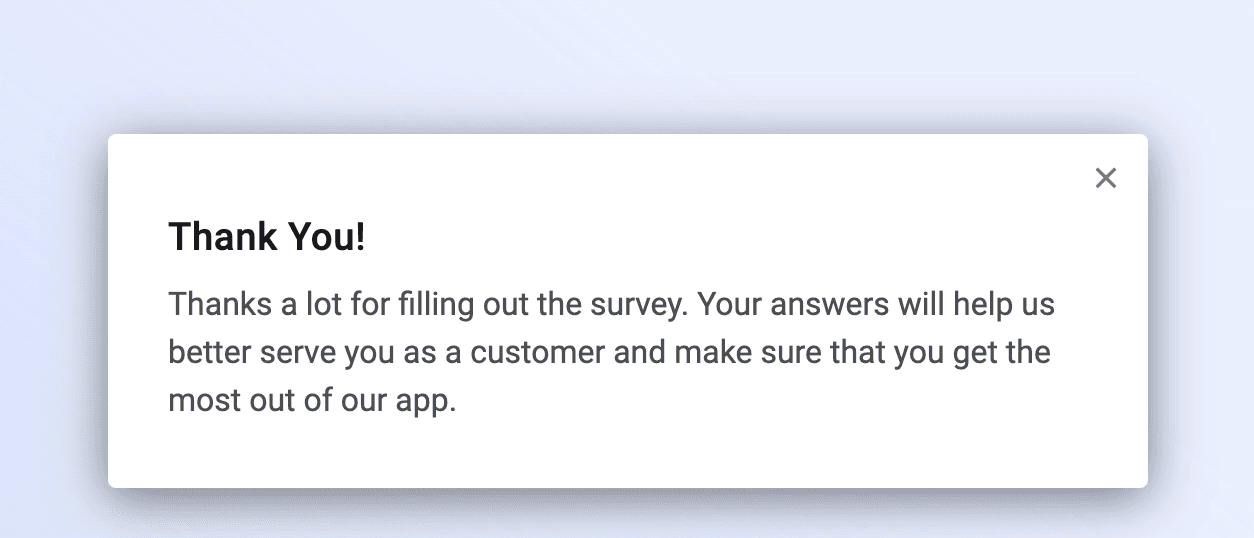
Offer incentives
Most customers dismiss surveys unless they get something in return 👀.
Ensure that incentives are relevant and attractive to your target audience. Be transparent about the incentive structure to maintain the integrity of the survey process and attract engaged and motivated participants. Some examples include:
Coupons
Gift cards
Special access to new product features
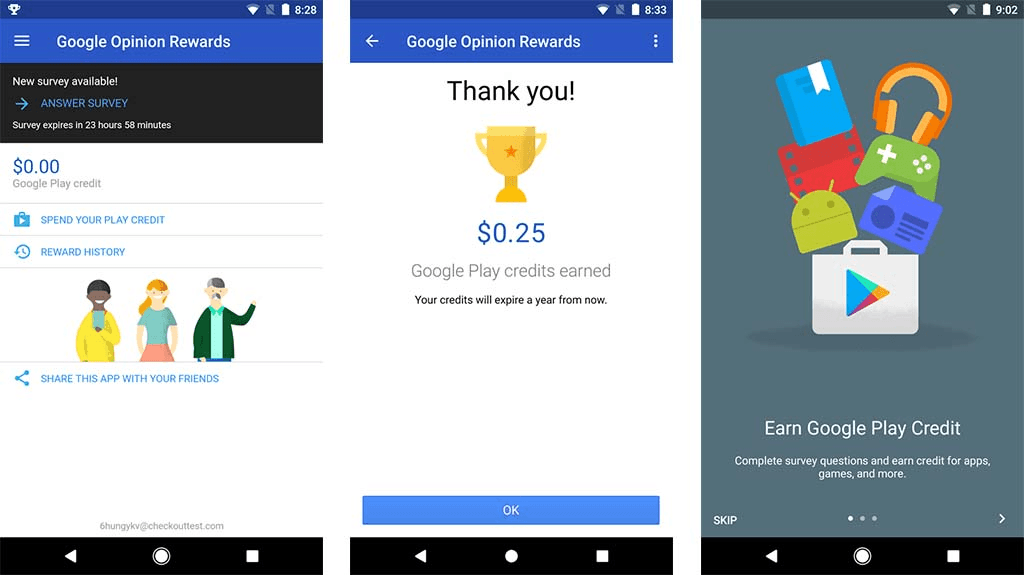
Regularly review and update surveys
Keep surveys up-to-date and relevant by regularly reviewing and updating them. Businesses evolve, and so do customer expectations. Assess the survey questions periodically to ensure they align with changing business priorities and customer needs.
Share survey results
Show your customers that you hear them. Providing a glimpse into how their feedback has influenced positive changes reinforces the value of their participation and encourages future engagement.
Here’s an example of how Threads improved their app according to user feedback:
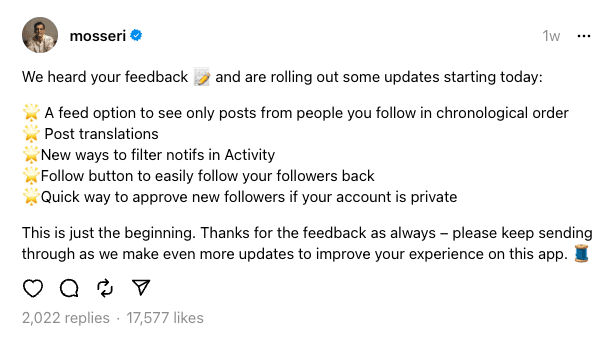
Choose the right customer feedback tool
Whether using websites, emails, or apps for surveys, the right tool makes everything smoother and gives you helpful customer insights.
Pick the right survey tool, as it's crucial for getting useful information and makes surveys efficient, accurate, and informative. Choose a tool that suits what you want to find out and who you're asking.
Easy-to-use tools keep people interested, customization makes the survey fit your needs, and analysis features help understand the data better.
💡1flow simplifies gathering feedback where product teams can launch in-app surveys minus the dev time. Access real-time contextual user insights to improve your product and provide a seamless customer experience.
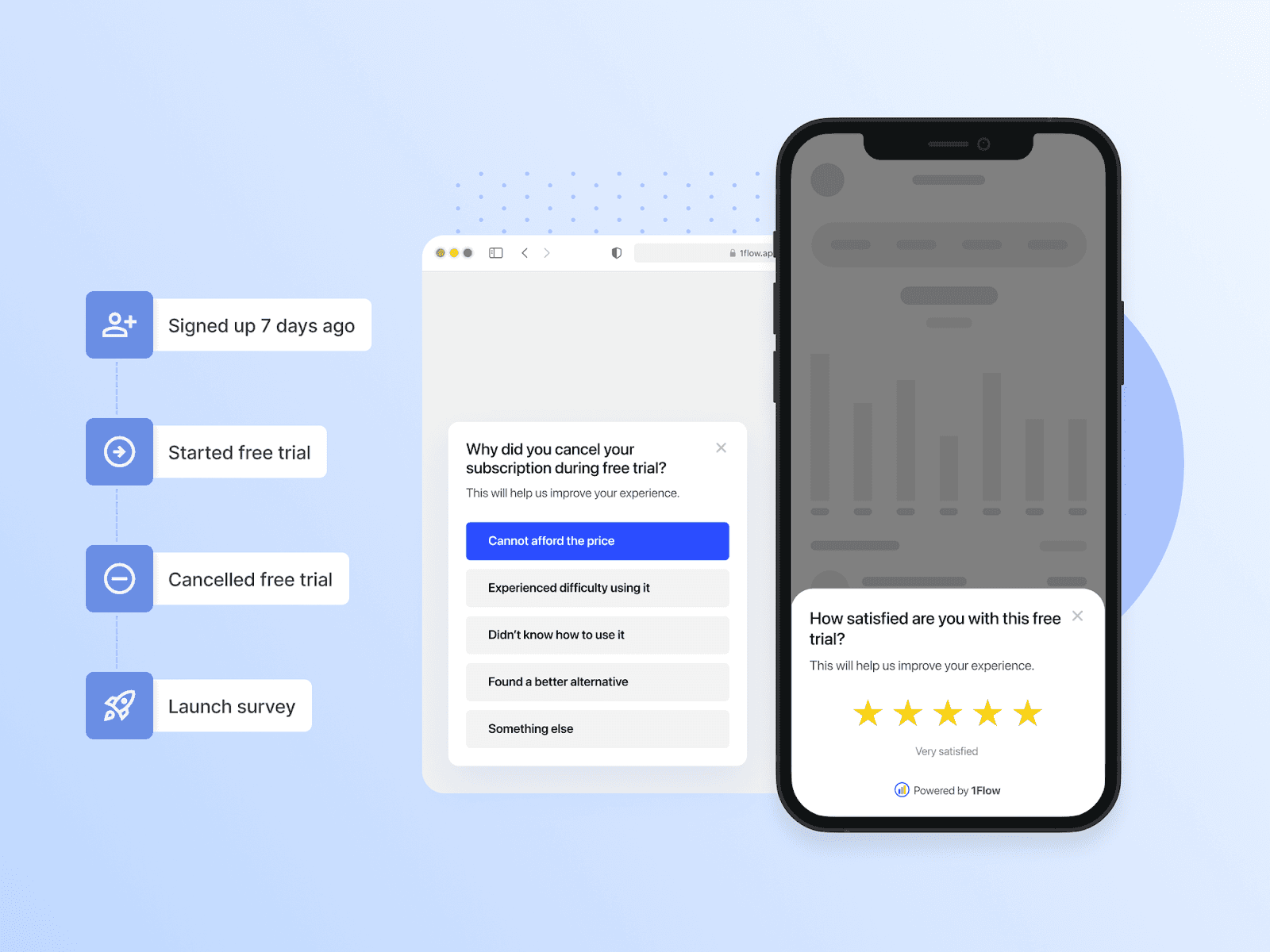
Find out how we help reduce churn and improve customer retention by taking a live demo.
Types of Customer Feedback Questions
You have to ask the right question to get the answer you’re looking for. Here are the 6 types of survey questions you can ask:
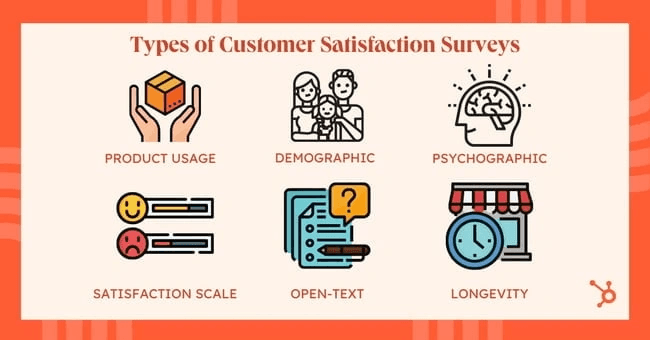
(We can recreate this image if the brand has an in-house design team)
Product Usage
Asking users about how they use your product gives you access to accurate data instead of relying on assumptions. You can finally know what they think of your product and whether they like using it. You can ask questions like:
How often do you use our products?
Which features are most valuable to you
What important features are we missing?
You get valuable insights for product research, which you can also use to tailor your marketing personas and sales strategy.
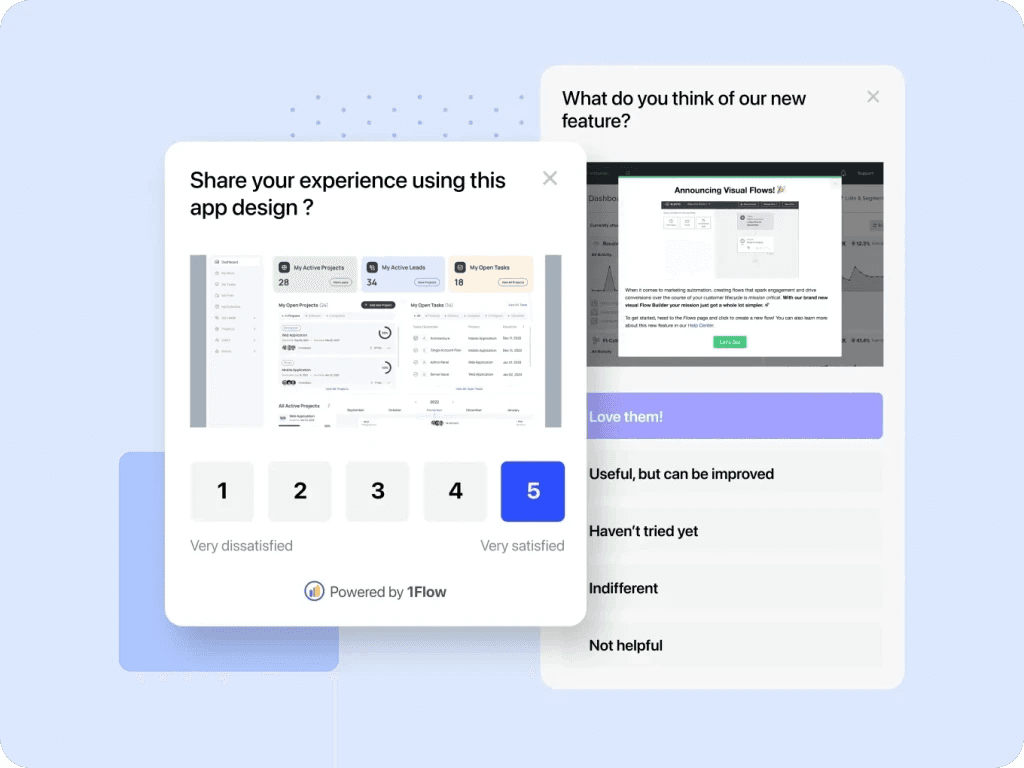
Demographics
If you’re creating a product for teenagers, you won’t send out customer feedback surveys to middle-aged folks, right? To get the right opinions, you must create demographic surveys to identify your target customers.
This can include asking questions about your age, profession, location, etc. Some examples include:
What gender do you identify as?
What is your annual household income?
What is your current employment status?
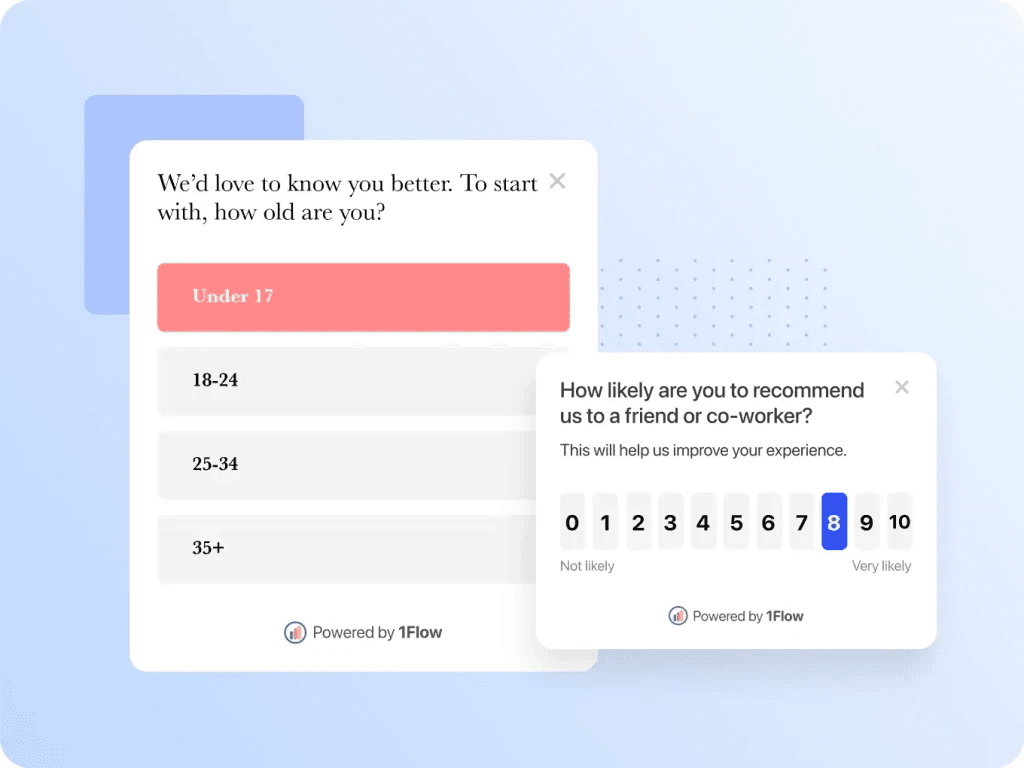
Demographic questions give you a clearer picture of your ideal buyers so you can improve your messaging accordingly.
Psychographics
Psychographic surveys gauge how your customers behave and what motivates them to buy. If you know more about your customers' thoughts, you can tailor your products to their needs. Here are a few questions you can ask:
Have you heard of [product name] before?
How would you feel if [product name] was no longer available?
How disappointed would you be if you could no longer use [Product/feature name?]
Satisfaction Scale
The Likert scale is used by brands all across the world to analyze customer satisfaction. It gives users a better way to articulate how they feel about a product without typing out detailed reviews. It is simple and effective and allows customers to quickly rate without spending much time on the survey. Some examples are:
Scale of 0-10
Scale of 1-5
Very unlikely – Very likely
Emoticons range of “Sad face” to “Happy face”
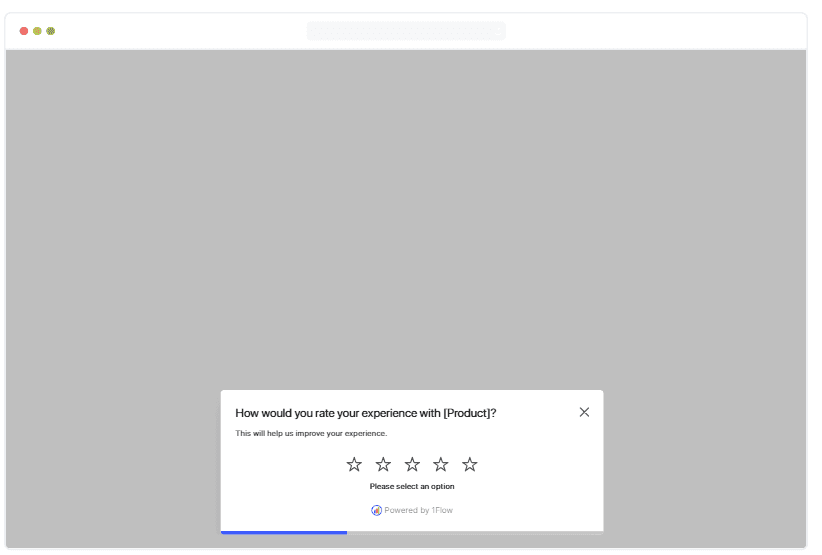
Open-Text
When you want to get more comprehensive responses to a survey – answers beyond just yes or no – you’ll want to consider open-ended questions.
Open-ended questions can offer you beneficial insights into your respondent’s viewpoints. Here are some example questions:
How could we improve our product to better meet your needs?
How would you compare our products to our competitors’?
What were the challenges you faced with us?
Open-ended questions help you get in-depth and accurate responses to better analyze sentiment amongst your audience.
Longevity
Longevity questions analyze the likelihood that a customer will continue using your product or service.
Here are some examples of longevity questions that you can include in your client satisfaction survey:
How likely are you to continue using our product/service in the future?
How likely are you to recommend our product/service to others?
Do you have any concerns that may impact your ability to continue using our product/service?
Longevity questions help you identify potential issues affecting customer loyalty and retention. When you understand the factors that influence customer loyalty, you can take steps to address underlying issues and make strategic decisions about how to improve your product or service and grow your business.
P.S.: You can create these online surveys using 1Flow’s AI generator so you can understand why users churn, what outcome they want to accomplish with your product, and how to build a better product that satisfies your customers.
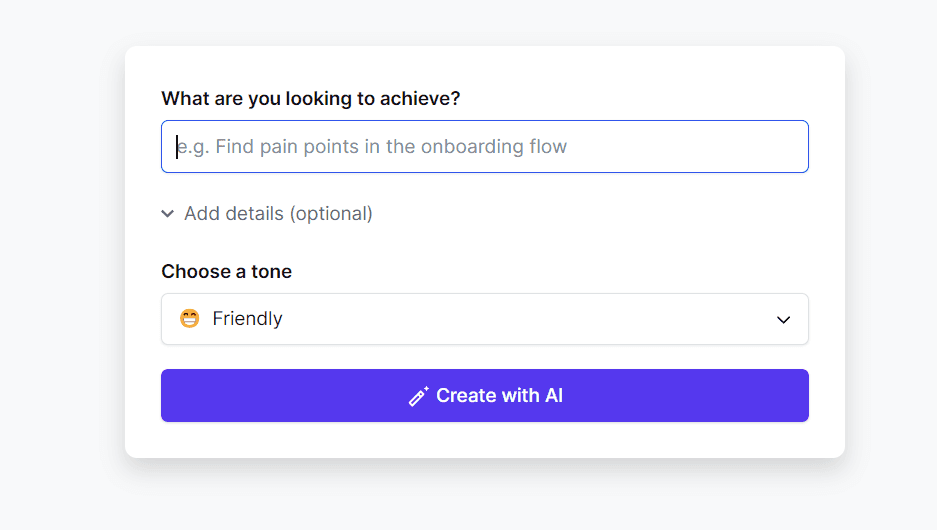
How To Use Customer Satisfaction Survey Results
Conducting regular surveys and maintaining an open line of communication with your customers will help foster a customer-centric culture within your organization. Here are steps to help you make the most of your survey data:
1. Thoroughly analyze the survey data and identify trends, patterns, and areas that need improvement. Look for both positive and negative feedback to gain a comprehensive understanding of customer perceptions.
2. Identify key metrics crucial for your business and customer satisfaction. These could include overall customer satisfaction scores, Net Promoter Score (NPS), or specific service/product-related metrics.
3. Segment customers based on different criteria, such as demographics and purchase history. This helps in identifying specific areas of improvement for different customer groups.
4. Prioritize the issues or areas that need attention. Focus on the most critical aspects that have the potential to make a significant impact on overall customer satisfaction.
5. Develop clear action plans based on identified areas for improvement. Instead of just knowing that customers are dissatisfied with a particular aspect, understand why and how it can be improved.
6. Communicate survey results across relevant teams within your organization. This ensures everyone knows customer feedback and can contribute to the improvement process.
7. Act on the valuable feedback received by executing the required changes. Whether it's improving a product feature, addressing customer service issues, or enhancing user experience, take tangible steps to address customer complaints
8. Inform your customers about the changes you're making based on their feedback. This shows your commitment to customer satisfaction and also helps in rebuilding trust.
9. Monitor and measure the impact of the changes regularly. Regularly track the effects of changes and adjust strategies accordingly. Use follow-up surveys to track improvements in customer satisfaction over time.
Customer satisfaction is an ongoing process. Regularly review and iterate on your products, services, and processes based on new feedback.
Customer Satisfaction Survey Examples from 4 Real Brands & Why They're Good!
Now that you’ve learned everything there’s to know about customer surveys, it’s time to see how the big brands do it. Here are 5 real-life examples of customer satisfaction surveys and why they work:
YouTube
Let’s be honest, no one likes ads while watching videos online. But what’s worse is seeing the same ad over and over again. YouTube inputs these surveys in the middle of videos to assess whether the ads are relevant to the user.
They also have a “skip survey” option so that viewers don’t feel pressured to input an answer, which works well because you won’t get incorrect data from folks who are uninterested in answering your questions.
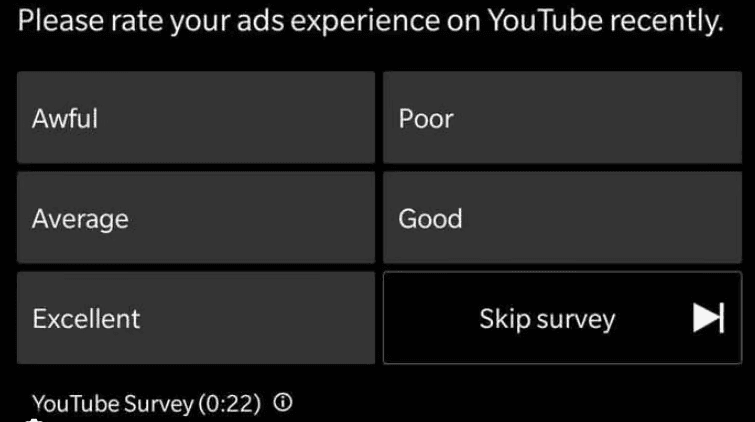
Zomato
When asking for feedback, it’s crucial to ask what exactly your customers like and dislike. Zomato does this well by adding a star rating system and asking specific questions that also benefit future customers who are interested in visiting a particular restaurant.

Uber
Everyone knows Uber allows you to rate drivers, but what stands out is the transparency for future passengers. If a driver has a lower rating, you can decline the ride. You can also compliment drivers and tip them via the app to make their day!
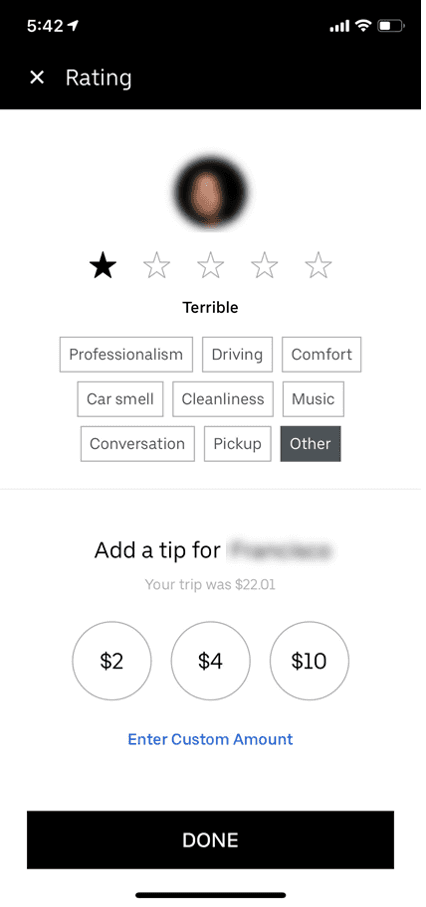
Subway
Restaurants must always keep their customers satisfied to keep business running smoothly.
Subway uses many customer survey question types to get a holistic answer from their consumers.
They use a Likert scale to assess whether customers are satisfied with the overall experience and ask an open-ended question in case users want to provide additional feedback.
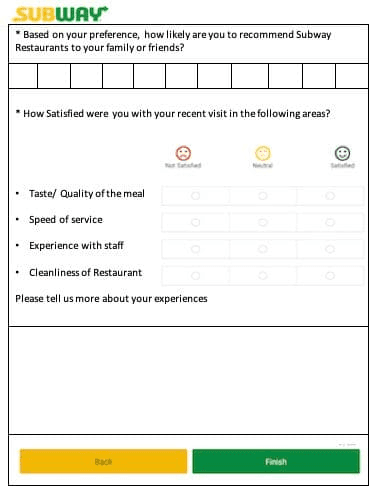
Using 1flow to Elevate Customer Surveys
Conducting customer surveys to improve user experience is critical, so ensure you have the right tool in your arsenal to get the job done.
Using the right CSAT tool streamlines the process of conducting customer surveys and gives you an accurate data-backed insight into how you can use these results to improve your product and best address user concerns.
1flow allows you to measure customer satisfaction through contextual in-app CSAT surveys so you can gather customer insights in no time.
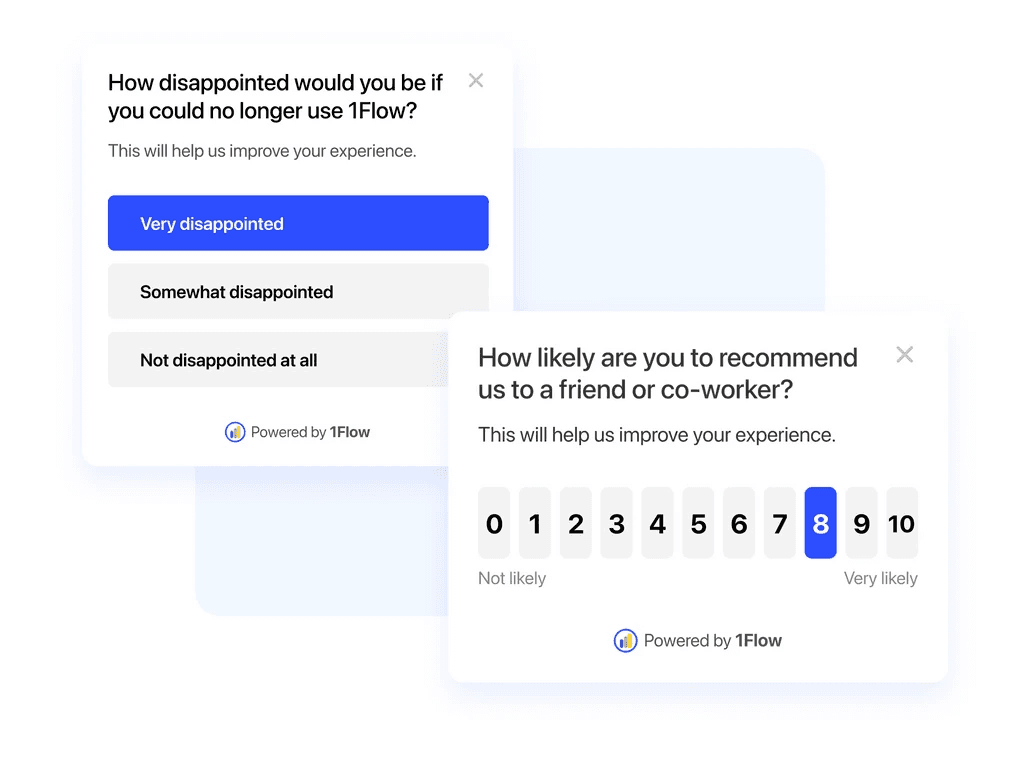
With 1Flow, you can:
Use AI to create personalized customer surveys with your unique branding
Engage users across web and mobile by using a unified profile to understand their behavior
Share product updates and onboard new users by embedding images and videos
Consolidate and analyze responses through analytics dashboards
Plus, you can access our robust library of user research survey templates when you sign up for a free account.
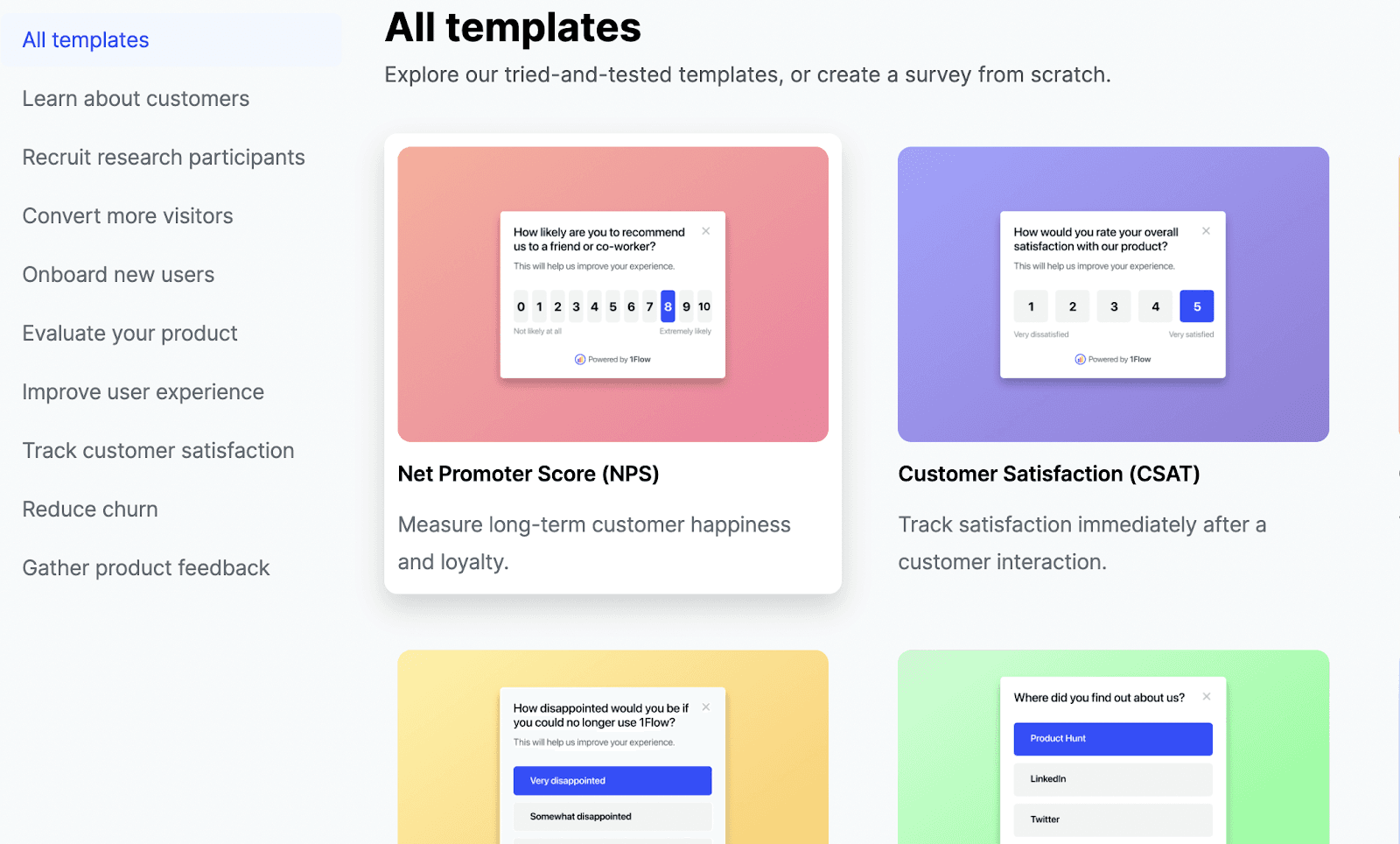
Want to conduct customer surveys the right way? Sign up for a free trial with 1Flow today!
What’s the secret to building a successful business? Two words: satisfied customers. 88% of buyers say experience matters as much as a company's products or services.
The best way to offer a positive customer experience is to understand what your customers really want, and that’s where customer satisfaction surveys come into play.
Conducting customer surveys isn’t just about mass emailing your customers a link to a survey and calling it a day.
It’s about crafting an intricate list of questions that give you actionable insights on how you can improve your products, reduce churn, and build a loyal customer base.
In this blog, we tell you the A-Z of conducting a customer satisfaction survey and how you can use survey results to become a customer-centric company.
What are customer surveys?
A customer survey is a questionnaire that brands send to ask what customers think about their products or services, brand, or other interactions with their business. The goal is to obtain and use feedback from customers to improve your product.
Customer surveys are the most direct way to collect constructive feedback from people who know the strengths and weaknesses of your products and services.
A good product paired with a good customer experience is the key to driving revenue. Remember that 52% of customers switch to a competitor after a negative experience.
If you want to avoid losing customers and revenue, you must survey your customers to uncover what they really want and resolve their needs in the right way.
How does CSAT work?
Customer Satisfaction Score or CSAT allows you to gauge your customers' satisfaction level. You can effortlessly track and monitor customers’ experiences after a particular transaction or at touchpoints like post-purchase, post-delivery, or after interacting with a customer support agent.
CSAT measures customer satisfaction by asking simple questions like 'How satisfied were you with your experience?' Rate your experience from 1 – 10.”

Why measure customer satisfaction constantly?
73% of consumers will switch to a competitor after a bad experience. If you are unaware of your customers' concerns and fail to resolve them, you risk customer churn and potential revenue from future customers.
“If you can’t measure it, you can’t fix it. If you care about customer satisfaction, I think you need the right mechanisms to measure customer satisfaction to get accurate data,” Derek Brown, Founder and CEO of Pronto Marketing.
Customer surveys are your CX team’s sidekick in uncovering how they can best improve their products and provide positive experiences for their buyers.
How to gather useful, constant customer feedback?
Getting feedback is just one piece of the puzzle. The main goal is to get accurate and honest customer feedback that you can actually use. Send out surveys you feel are apt for your category and industry.
According to research, 64% of consumers appreciate when a brand seeks their feedback or opinions in a survey. But they’d want to answer relevant questions about optimizing customer experience.

Source: Khoros
Here are a few tips on gathering helpful and direct feedback from customers:
Send out feedback forms via multiple channels
Monitor social media
Embed surveys on websites via live chat
Create an online community
12 Best practices for customer satisfaction surveys
Creating effective surveys requires thoughtful consideration of various factors to ensure meaningful and actionable insights.
Here are 12 best practices you can follow to create customer satisfaction surveys that strengthen customer relationships and drive overall business improvement:
Ask the right person
If you’re building a tool for marketers, you shouldn’t send out customer surveys to lawyers. Make sure you ask the right audience for feedback to get a proper insight into how you can get more satisfied customers,
The single best attribute to qualify somebody as your target is somebody who already interacted with your brand. This could be post-purchase or ones who dropped off before making a purchase.
Keep it clear and concise
Customers get many surveys from brands and don’t have the time to fill them all. Keep your surveys short to avoid survey fatigue and prioritize questions directly contributing to your objectives.
A shorter, more focused survey will likely be completed, leading to higher response rates and more accurate data.
Ensure that the survey questions are easy to understand. Avoid technical terms or jargon that may be unclear to your audience or lead to confusion or misinterpretation.
Send your survey at the right time
Timing is everything, especially when gathering customer feedback. Send out surveys shortly after they’ve used or purchased your product so you can get feedback while it's still fresh in their minds.

Source: CheckMarket
Include a mix of question types
Use various question types to gather diverse insights. Combine open-ended questions to encourage respondents to provide detailed, qualitative feedback and closed-ended questions (multiple choice questions, rating scales) for quantitative data.
This mix allows you to quantify trends while gaining deeper insights into customers' thoughts and feelings.
Establish a logical flow
Organize survey questions in a logical sequence that follows a natural flow. Before diving into more specific or complex topics, start with general, easy-to-answer questions. Make a group of related questions together to maintain coherence.
A well-organized survey enhances the respondent experience and completion rates and makes it easier for participants to provide thoughtful responses, improving the overall user experience.
Ensure mobile responsiveness
The majority of the people in your customer base use mobile phones to answer surveys. Optimize your survey for mobile devices to accommodate the diverse ways customers access and engage with content.
Test the survey on various devices to guarantee a seamless experience for respondents regardless of the platform they use.
Responsive design is essential for increasing participation and gaining diverse feedback. 1flow allows you to create CSAT surveys that are both desktop and mobile-friendly.
Express gratitude
Don’t just send out surveys and call it a day. Acknowledge their contribution and highlight the importance of their feedback. Consider summarizing the survey results or explaining how their feedback will be used for further improvements.

Offer incentives
Most customers dismiss surveys unless they get something in return 👀.
Ensure that incentives are relevant and attractive to your target audience. Be transparent about the incentive structure to maintain the integrity of the survey process and attract engaged and motivated participants. Some examples include:
Coupons
Gift cards
Special access to new product features

Regularly review and update surveys
Keep surveys up-to-date and relevant by regularly reviewing and updating them. Businesses evolve, and so do customer expectations. Assess the survey questions periodically to ensure they align with changing business priorities and customer needs.
Share survey results
Show your customers that you hear them. Providing a glimpse into how their feedback has influenced positive changes reinforces the value of their participation and encourages future engagement.
Here’s an example of how Threads improved their app according to user feedback:

Choose the right customer feedback tool
Whether using websites, emails, or apps for surveys, the right tool makes everything smoother and gives you helpful customer insights.
Pick the right survey tool, as it's crucial for getting useful information and makes surveys efficient, accurate, and informative. Choose a tool that suits what you want to find out and who you're asking.
Easy-to-use tools keep people interested, customization makes the survey fit your needs, and analysis features help understand the data better.
💡1flow simplifies gathering feedback where product teams can launch in-app surveys minus the dev time. Access real-time contextual user insights to improve your product and provide a seamless customer experience.

Find out how we help reduce churn and improve customer retention by taking a live demo.
Types of Customer Feedback Questions
You have to ask the right question to get the answer you’re looking for. Here are the 6 types of survey questions you can ask:

(We can recreate this image if the brand has an in-house design team)
Product Usage
Asking users about how they use your product gives you access to accurate data instead of relying on assumptions. You can finally know what they think of your product and whether they like using it. You can ask questions like:
How often do you use our products?
Which features are most valuable to you
What important features are we missing?
You get valuable insights for product research, which you can also use to tailor your marketing personas and sales strategy.

Demographics
If you’re creating a product for teenagers, you won’t send out customer feedback surveys to middle-aged folks, right? To get the right opinions, you must create demographic surveys to identify your target customers.
This can include asking questions about your age, profession, location, etc. Some examples include:
What gender do you identify as?
What is your annual household income?
What is your current employment status?

Demographic questions give you a clearer picture of your ideal buyers so you can improve your messaging accordingly.
Psychographics
Psychographic surveys gauge how your customers behave and what motivates them to buy. If you know more about your customers' thoughts, you can tailor your products to their needs. Here are a few questions you can ask:
Have you heard of [product name] before?
How would you feel if [product name] was no longer available?
How disappointed would you be if you could no longer use [Product/feature name?]
Satisfaction Scale
The Likert scale is used by brands all across the world to analyze customer satisfaction. It gives users a better way to articulate how they feel about a product without typing out detailed reviews. It is simple and effective and allows customers to quickly rate without spending much time on the survey. Some examples are:
Scale of 0-10
Scale of 1-5
Very unlikely – Very likely
Emoticons range of “Sad face” to “Happy face”

Open-Text
When you want to get more comprehensive responses to a survey – answers beyond just yes or no – you’ll want to consider open-ended questions.
Open-ended questions can offer you beneficial insights into your respondent’s viewpoints. Here are some example questions:
How could we improve our product to better meet your needs?
How would you compare our products to our competitors’?
What were the challenges you faced with us?
Open-ended questions help you get in-depth and accurate responses to better analyze sentiment amongst your audience.
Longevity
Longevity questions analyze the likelihood that a customer will continue using your product or service.
Here are some examples of longevity questions that you can include in your client satisfaction survey:
How likely are you to continue using our product/service in the future?
How likely are you to recommend our product/service to others?
Do you have any concerns that may impact your ability to continue using our product/service?
Longevity questions help you identify potential issues affecting customer loyalty and retention. When you understand the factors that influence customer loyalty, you can take steps to address underlying issues and make strategic decisions about how to improve your product or service and grow your business.
P.S.: You can create these online surveys using 1Flow’s AI generator so you can understand why users churn, what outcome they want to accomplish with your product, and how to build a better product that satisfies your customers.

How To Use Customer Satisfaction Survey Results
Conducting regular surveys and maintaining an open line of communication with your customers will help foster a customer-centric culture within your organization. Here are steps to help you make the most of your survey data:
1. Thoroughly analyze the survey data and identify trends, patterns, and areas that need improvement. Look for both positive and negative feedback to gain a comprehensive understanding of customer perceptions.
2. Identify key metrics crucial for your business and customer satisfaction. These could include overall customer satisfaction scores, Net Promoter Score (NPS), or specific service/product-related metrics.
3. Segment customers based on different criteria, such as demographics and purchase history. This helps in identifying specific areas of improvement for different customer groups.
4. Prioritize the issues or areas that need attention. Focus on the most critical aspects that have the potential to make a significant impact on overall customer satisfaction.
5. Develop clear action plans based on identified areas for improvement. Instead of just knowing that customers are dissatisfied with a particular aspect, understand why and how it can be improved.
6. Communicate survey results across relevant teams within your organization. This ensures everyone knows customer feedback and can contribute to the improvement process.
7. Act on the valuable feedback received by executing the required changes. Whether it's improving a product feature, addressing customer service issues, or enhancing user experience, take tangible steps to address customer complaints
8. Inform your customers about the changes you're making based on their feedback. This shows your commitment to customer satisfaction and also helps in rebuilding trust.
9. Monitor and measure the impact of the changes regularly. Regularly track the effects of changes and adjust strategies accordingly. Use follow-up surveys to track improvements in customer satisfaction over time.
Customer satisfaction is an ongoing process. Regularly review and iterate on your products, services, and processes based on new feedback.
Customer Satisfaction Survey Examples from 4 Real Brands & Why They're Good!
Now that you’ve learned everything there’s to know about customer surveys, it’s time to see how the big brands do it. Here are 5 real-life examples of customer satisfaction surveys and why they work:
YouTube
Let’s be honest, no one likes ads while watching videos online. But what’s worse is seeing the same ad over and over again. YouTube inputs these surveys in the middle of videos to assess whether the ads are relevant to the user.
They also have a “skip survey” option so that viewers don’t feel pressured to input an answer, which works well because you won’t get incorrect data from folks who are uninterested in answering your questions.

Zomato
When asking for feedback, it’s crucial to ask what exactly your customers like and dislike. Zomato does this well by adding a star rating system and asking specific questions that also benefit future customers who are interested in visiting a particular restaurant.

Uber
Everyone knows Uber allows you to rate drivers, but what stands out is the transparency for future passengers. If a driver has a lower rating, you can decline the ride. You can also compliment drivers and tip them via the app to make their day!

Subway
Restaurants must always keep their customers satisfied to keep business running smoothly.
Subway uses many customer survey question types to get a holistic answer from their consumers.
They use a Likert scale to assess whether customers are satisfied with the overall experience and ask an open-ended question in case users want to provide additional feedback.

Using 1flow to Elevate Customer Surveys
Conducting customer surveys to improve user experience is critical, so ensure you have the right tool in your arsenal to get the job done.
Using the right CSAT tool streamlines the process of conducting customer surveys and gives you an accurate data-backed insight into how you can use these results to improve your product and best address user concerns.
1flow allows you to measure customer satisfaction through contextual in-app CSAT surveys so you can gather customer insights in no time.

With 1Flow, you can:
Use AI to create personalized customer surveys with your unique branding
Engage users across web and mobile by using a unified profile to understand their behavior
Share product updates and onboard new users by embedding images and videos
Consolidate and analyze responses through analytics dashboards
Plus, you can access our robust library of user research survey templates when you sign up for a free account.

Want to conduct customer surveys the right way? Sign up for a free trial with 1Flow today!
What’s the secret to building a successful business? Two words: satisfied customers. 88% of buyers say experience matters as much as a company's products or services.
The best way to offer a positive customer experience is to understand what your customers really want, and that’s where customer satisfaction surveys come into play.
Conducting customer surveys isn’t just about mass emailing your customers a link to a survey and calling it a day.
It’s about crafting an intricate list of questions that give you actionable insights on how you can improve your products, reduce churn, and build a loyal customer base.
In this blog, we tell you the A-Z of conducting a customer satisfaction survey and how you can use survey results to become a customer-centric company.
What are customer surveys?
A customer survey is a questionnaire that brands send to ask what customers think about their products or services, brand, or other interactions with their business. The goal is to obtain and use feedback from customers to improve your product.
Customer surveys are the most direct way to collect constructive feedback from people who know the strengths and weaknesses of your products and services.
A good product paired with a good customer experience is the key to driving revenue. Remember that 52% of customers switch to a competitor after a negative experience.
If you want to avoid losing customers and revenue, you must survey your customers to uncover what they really want and resolve their needs in the right way.
How does CSAT work?
Customer Satisfaction Score or CSAT allows you to gauge your customers' satisfaction level. You can effortlessly track and monitor customers’ experiences after a particular transaction or at touchpoints like post-purchase, post-delivery, or after interacting with a customer support agent.
CSAT measures customer satisfaction by asking simple questions like 'How satisfied were you with your experience?' Rate your experience from 1 – 10.”

Why measure customer satisfaction constantly?
73% of consumers will switch to a competitor after a bad experience. If you are unaware of your customers' concerns and fail to resolve them, you risk customer churn and potential revenue from future customers.
“If you can’t measure it, you can’t fix it. If you care about customer satisfaction, I think you need the right mechanisms to measure customer satisfaction to get accurate data,” Derek Brown, Founder and CEO of Pronto Marketing.
Customer surveys are your CX team’s sidekick in uncovering how they can best improve their products and provide positive experiences for their buyers.
How to gather useful, constant customer feedback?
Getting feedback is just one piece of the puzzle. The main goal is to get accurate and honest customer feedback that you can actually use. Send out surveys you feel are apt for your category and industry.
According to research, 64% of consumers appreciate when a brand seeks their feedback or opinions in a survey. But they’d want to answer relevant questions about optimizing customer experience.

Source: Khoros
Here are a few tips on gathering helpful and direct feedback from customers:
Send out feedback forms via multiple channels
Monitor social media
Embed surveys on websites via live chat
Create an online community
12 Best practices for customer satisfaction surveys
Creating effective surveys requires thoughtful consideration of various factors to ensure meaningful and actionable insights.
Here are 12 best practices you can follow to create customer satisfaction surveys that strengthen customer relationships and drive overall business improvement:
Ask the right person
If you’re building a tool for marketers, you shouldn’t send out customer surveys to lawyers. Make sure you ask the right audience for feedback to get a proper insight into how you can get more satisfied customers,
The single best attribute to qualify somebody as your target is somebody who already interacted with your brand. This could be post-purchase or ones who dropped off before making a purchase.
Keep it clear and concise
Customers get many surveys from brands and don’t have the time to fill them all. Keep your surveys short to avoid survey fatigue and prioritize questions directly contributing to your objectives.
A shorter, more focused survey will likely be completed, leading to higher response rates and more accurate data.
Ensure that the survey questions are easy to understand. Avoid technical terms or jargon that may be unclear to your audience or lead to confusion or misinterpretation.
Send your survey at the right time
Timing is everything, especially when gathering customer feedback. Send out surveys shortly after they’ve used or purchased your product so you can get feedback while it's still fresh in their minds.

Source: CheckMarket
Include a mix of question types
Use various question types to gather diverse insights. Combine open-ended questions to encourage respondents to provide detailed, qualitative feedback and closed-ended questions (multiple choice questions, rating scales) for quantitative data.
This mix allows you to quantify trends while gaining deeper insights into customers' thoughts and feelings.
Establish a logical flow
Organize survey questions in a logical sequence that follows a natural flow. Before diving into more specific or complex topics, start with general, easy-to-answer questions. Make a group of related questions together to maintain coherence.
A well-organized survey enhances the respondent experience and completion rates and makes it easier for participants to provide thoughtful responses, improving the overall user experience.
Ensure mobile responsiveness
The majority of the people in your customer base use mobile phones to answer surveys. Optimize your survey for mobile devices to accommodate the diverse ways customers access and engage with content.
Test the survey on various devices to guarantee a seamless experience for respondents regardless of the platform they use.
Responsive design is essential for increasing participation and gaining diverse feedback. 1flow allows you to create CSAT surveys that are both desktop and mobile-friendly.
Express gratitude
Don’t just send out surveys and call it a day. Acknowledge their contribution and highlight the importance of their feedback. Consider summarizing the survey results or explaining how their feedback will be used for further improvements.

Offer incentives
Most customers dismiss surveys unless they get something in return 👀.
Ensure that incentives are relevant and attractive to your target audience. Be transparent about the incentive structure to maintain the integrity of the survey process and attract engaged and motivated participants. Some examples include:
Coupons
Gift cards
Special access to new product features

Regularly review and update surveys
Keep surveys up-to-date and relevant by regularly reviewing and updating them. Businesses evolve, and so do customer expectations. Assess the survey questions periodically to ensure they align with changing business priorities and customer needs.
Share survey results
Show your customers that you hear them. Providing a glimpse into how their feedback has influenced positive changes reinforces the value of their participation and encourages future engagement.
Here’s an example of how Threads improved their app according to user feedback:

Choose the right customer feedback tool
Whether using websites, emails, or apps for surveys, the right tool makes everything smoother and gives you helpful customer insights.
Pick the right survey tool, as it's crucial for getting useful information and makes surveys efficient, accurate, and informative. Choose a tool that suits what you want to find out and who you're asking.
Easy-to-use tools keep people interested, customization makes the survey fit your needs, and analysis features help understand the data better.
💡1flow simplifies gathering feedback where product teams can launch in-app surveys minus the dev time. Access real-time contextual user insights to improve your product and provide a seamless customer experience.

Find out how we help reduce churn and improve customer retention by taking a live demo.
Types of Customer Feedback Questions
You have to ask the right question to get the answer you’re looking for. Here are the 6 types of survey questions you can ask:

(We can recreate this image if the brand has an in-house design team)
Product Usage
Asking users about how they use your product gives you access to accurate data instead of relying on assumptions. You can finally know what they think of your product and whether they like using it. You can ask questions like:
How often do you use our products?
Which features are most valuable to you
What important features are we missing?
You get valuable insights for product research, which you can also use to tailor your marketing personas and sales strategy.

Demographics
If you’re creating a product for teenagers, you won’t send out customer feedback surveys to middle-aged folks, right? To get the right opinions, you must create demographic surveys to identify your target customers.
This can include asking questions about your age, profession, location, etc. Some examples include:
What gender do you identify as?
What is your annual household income?
What is your current employment status?

Demographic questions give you a clearer picture of your ideal buyers so you can improve your messaging accordingly.
Psychographics
Psychographic surveys gauge how your customers behave and what motivates them to buy. If you know more about your customers' thoughts, you can tailor your products to their needs. Here are a few questions you can ask:
Have you heard of [product name] before?
How would you feel if [product name] was no longer available?
How disappointed would you be if you could no longer use [Product/feature name?]
Satisfaction Scale
The Likert scale is used by brands all across the world to analyze customer satisfaction. It gives users a better way to articulate how they feel about a product without typing out detailed reviews. It is simple and effective and allows customers to quickly rate without spending much time on the survey. Some examples are:
Scale of 0-10
Scale of 1-5
Very unlikely – Very likely
Emoticons range of “Sad face” to “Happy face”

Open-Text
When you want to get more comprehensive responses to a survey – answers beyond just yes or no – you’ll want to consider open-ended questions.
Open-ended questions can offer you beneficial insights into your respondent’s viewpoints. Here are some example questions:
How could we improve our product to better meet your needs?
How would you compare our products to our competitors’?
What were the challenges you faced with us?
Open-ended questions help you get in-depth and accurate responses to better analyze sentiment amongst your audience.
Longevity
Longevity questions analyze the likelihood that a customer will continue using your product or service.
Here are some examples of longevity questions that you can include in your client satisfaction survey:
How likely are you to continue using our product/service in the future?
How likely are you to recommend our product/service to others?
Do you have any concerns that may impact your ability to continue using our product/service?
Longevity questions help you identify potential issues affecting customer loyalty and retention. When you understand the factors that influence customer loyalty, you can take steps to address underlying issues and make strategic decisions about how to improve your product or service and grow your business.
P.S.: You can create these online surveys using 1Flow’s AI generator so you can understand why users churn, what outcome they want to accomplish with your product, and how to build a better product that satisfies your customers.

How To Use Customer Satisfaction Survey Results
Conducting regular surveys and maintaining an open line of communication with your customers will help foster a customer-centric culture within your organization. Here are steps to help you make the most of your survey data:
1. Thoroughly analyze the survey data and identify trends, patterns, and areas that need improvement. Look for both positive and negative feedback to gain a comprehensive understanding of customer perceptions.
2. Identify key metrics crucial for your business and customer satisfaction. These could include overall customer satisfaction scores, Net Promoter Score (NPS), or specific service/product-related metrics.
3. Segment customers based on different criteria, such as demographics and purchase history. This helps in identifying specific areas of improvement for different customer groups.
4. Prioritize the issues or areas that need attention. Focus on the most critical aspects that have the potential to make a significant impact on overall customer satisfaction.
5. Develop clear action plans based on identified areas for improvement. Instead of just knowing that customers are dissatisfied with a particular aspect, understand why and how it can be improved.
6. Communicate survey results across relevant teams within your organization. This ensures everyone knows customer feedback and can contribute to the improvement process.
7. Act on the valuable feedback received by executing the required changes. Whether it's improving a product feature, addressing customer service issues, or enhancing user experience, take tangible steps to address customer complaints
8. Inform your customers about the changes you're making based on their feedback. This shows your commitment to customer satisfaction and also helps in rebuilding trust.
9. Monitor and measure the impact of the changes regularly. Regularly track the effects of changes and adjust strategies accordingly. Use follow-up surveys to track improvements in customer satisfaction over time.
Customer satisfaction is an ongoing process. Regularly review and iterate on your products, services, and processes based on new feedback.
Customer Satisfaction Survey Examples from 4 Real Brands & Why They're Good!
Now that you’ve learned everything there’s to know about customer surveys, it’s time to see how the big brands do it. Here are 5 real-life examples of customer satisfaction surveys and why they work:
YouTube
Let’s be honest, no one likes ads while watching videos online. But what’s worse is seeing the same ad over and over again. YouTube inputs these surveys in the middle of videos to assess whether the ads are relevant to the user.
They also have a “skip survey” option so that viewers don’t feel pressured to input an answer, which works well because you won’t get incorrect data from folks who are uninterested in answering your questions.

Zomato
When asking for feedback, it’s crucial to ask what exactly your customers like and dislike. Zomato does this well by adding a star rating system and asking specific questions that also benefit future customers who are interested in visiting a particular restaurant.

Uber
Everyone knows Uber allows you to rate drivers, but what stands out is the transparency for future passengers. If a driver has a lower rating, you can decline the ride. You can also compliment drivers and tip them via the app to make their day!

Subway
Restaurants must always keep their customers satisfied to keep business running smoothly.
Subway uses many customer survey question types to get a holistic answer from their consumers.
They use a Likert scale to assess whether customers are satisfied with the overall experience and ask an open-ended question in case users want to provide additional feedback.

Using 1flow to Elevate Customer Surveys
Conducting customer surveys to improve user experience is critical, so ensure you have the right tool in your arsenal to get the job done.
Using the right CSAT tool streamlines the process of conducting customer surveys and gives you an accurate data-backed insight into how you can use these results to improve your product and best address user concerns.
1flow allows you to measure customer satisfaction through contextual in-app CSAT surveys so you can gather customer insights in no time.

With 1Flow, you can:
Use AI to create personalized customer surveys with your unique branding
Engage users across web and mobile by using a unified profile to understand their behavior
Share product updates and onboard new users by embedding images and videos
Consolidate and analyze responses through analytics dashboards
Plus, you can access our robust library of user research survey templates when you sign up for a free account.

Want to conduct customer surveys the right way? Sign up for a free trial with 1Flow today!
What’s the secret to building a successful business? Two words: satisfied customers. 88% of buyers say experience matters as much as a company's products or services.
The best way to offer a positive customer experience is to understand what your customers really want, and that’s where customer satisfaction surveys come into play.
Conducting customer surveys isn’t just about mass emailing your customers a link to a survey and calling it a day.
It’s about crafting an intricate list of questions that give you actionable insights on how you can improve your products, reduce churn, and build a loyal customer base.
In this blog, we tell you the A-Z of conducting a customer satisfaction survey and how you can use survey results to become a customer-centric company.
What are customer surveys?
A customer survey is a questionnaire that brands send to ask what customers think about their products or services, brand, or other interactions with their business. The goal is to obtain and use feedback from customers to improve your product.
Customer surveys are the most direct way to collect constructive feedback from people who know the strengths and weaknesses of your products and services.
A good product paired with a good customer experience is the key to driving revenue. Remember that 52% of customers switch to a competitor after a negative experience.
If you want to avoid losing customers and revenue, you must survey your customers to uncover what they really want and resolve their needs in the right way.
How does CSAT work?
Customer Satisfaction Score or CSAT allows you to gauge your customers' satisfaction level. You can effortlessly track and monitor customers’ experiences after a particular transaction or at touchpoints like post-purchase, post-delivery, or after interacting with a customer support agent.
CSAT measures customer satisfaction by asking simple questions like 'How satisfied were you with your experience?' Rate your experience from 1 – 10.”

Why measure customer satisfaction constantly?
73% of consumers will switch to a competitor after a bad experience. If you are unaware of your customers' concerns and fail to resolve them, you risk customer churn and potential revenue from future customers.
“If you can’t measure it, you can’t fix it. If you care about customer satisfaction, I think you need the right mechanisms to measure customer satisfaction to get accurate data,” Derek Brown, Founder and CEO of Pronto Marketing.
Customer surveys are your CX team’s sidekick in uncovering how they can best improve their products and provide positive experiences for their buyers.
How to gather useful, constant customer feedback?
Getting feedback is just one piece of the puzzle. The main goal is to get accurate and honest customer feedback that you can actually use. Send out surveys you feel are apt for your category and industry.
According to research, 64% of consumers appreciate when a brand seeks their feedback or opinions in a survey. But they’d want to answer relevant questions about optimizing customer experience.

Source: Khoros
Here are a few tips on gathering helpful and direct feedback from customers:
Send out feedback forms via multiple channels
Monitor social media
Embed surveys on websites via live chat
Create an online community
12 Best practices for customer satisfaction surveys
Creating effective surveys requires thoughtful consideration of various factors to ensure meaningful and actionable insights.
Here are 12 best practices you can follow to create customer satisfaction surveys that strengthen customer relationships and drive overall business improvement:
Ask the right person
If you’re building a tool for marketers, you shouldn’t send out customer surveys to lawyers. Make sure you ask the right audience for feedback to get a proper insight into how you can get more satisfied customers,
The single best attribute to qualify somebody as your target is somebody who already interacted with your brand. This could be post-purchase or ones who dropped off before making a purchase.
Keep it clear and concise
Customers get many surveys from brands and don’t have the time to fill them all. Keep your surveys short to avoid survey fatigue and prioritize questions directly contributing to your objectives.
A shorter, more focused survey will likely be completed, leading to higher response rates and more accurate data.
Ensure that the survey questions are easy to understand. Avoid technical terms or jargon that may be unclear to your audience or lead to confusion or misinterpretation.
Send your survey at the right time
Timing is everything, especially when gathering customer feedback. Send out surveys shortly after they’ve used or purchased your product so you can get feedback while it's still fresh in their minds.

Source: CheckMarket
Include a mix of question types
Use various question types to gather diverse insights. Combine open-ended questions to encourage respondents to provide detailed, qualitative feedback and closed-ended questions (multiple choice questions, rating scales) for quantitative data.
This mix allows you to quantify trends while gaining deeper insights into customers' thoughts and feelings.
Establish a logical flow
Organize survey questions in a logical sequence that follows a natural flow. Before diving into more specific or complex topics, start with general, easy-to-answer questions. Make a group of related questions together to maintain coherence.
A well-organized survey enhances the respondent experience and completion rates and makes it easier for participants to provide thoughtful responses, improving the overall user experience.
Ensure mobile responsiveness
The majority of the people in your customer base use mobile phones to answer surveys. Optimize your survey for mobile devices to accommodate the diverse ways customers access and engage with content.
Test the survey on various devices to guarantee a seamless experience for respondents regardless of the platform they use.
Responsive design is essential for increasing participation and gaining diverse feedback. 1flow allows you to create CSAT surveys that are both desktop and mobile-friendly.
Express gratitude
Don’t just send out surveys and call it a day. Acknowledge their contribution and highlight the importance of their feedback. Consider summarizing the survey results or explaining how their feedback will be used for further improvements.

Offer incentives
Most customers dismiss surveys unless they get something in return 👀.
Ensure that incentives are relevant and attractive to your target audience. Be transparent about the incentive structure to maintain the integrity of the survey process and attract engaged and motivated participants. Some examples include:
Coupons
Gift cards
Special access to new product features

Regularly review and update surveys
Keep surveys up-to-date and relevant by regularly reviewing and updating them. Businesses evolve, and so do customer expectations. Assess the survey questions periodically to ensure they align with changing business priorities and customer needs.
Share survey results
Show your customers that you hear them. Providing a glimpse into how their feedback has influenced positive changes reinforces the value of their participation and encourages future engagement.
Here’s an example of how Threads improved their app according to user feedback:

Choose the right customer feedback tool
Whether using websites, emails, or apps for surveys, the right tool makes everything smoother and gives you helpful customer insights.
Pick the right survey tool, as it's crucial for getting useful information and makes surveys efficient, accurate, and informative. Choose a tool that suits what you want to find out and who you're asking.
Easy-to-use tools keep people interested, customization makes the survey fit your needs, and analysis features help understand the data better.
💡1flow simplifies gathering feedback where product teams can launch in-app surveys minus the dev time. Access real-time contextual user insights to improve your product and provide a seamless customer experience.

Find out how we help reduce churn and improve customer retention by taking a live demo.
Types of Customer Feedback Questions
You have to ask the right question to get the answer you’re looking for. Here are the 6 types of survey questions you can ask:

(We can recreate this image if the brand has an in-house design team)
Product Usage
Asking users about how they use your product gives you access to accurate data instead of relying on assumptions. You can finally know what they think of your product and whether they like using it. You can ask questions like:
How often do you use our products?
Which features are most valuable to you
What important features are we missing?
You get valuable insights for product research, which you can also use to tailor your marketing personas and sales strategy.

Demographics
If you’re creating a product for teenagers, you won’t send out customer feedback surveys to middle-aged folks, right? To get the right opinions, you must create demographic surveys to identify your target customers.
This can include asking questions about your age, profession, location, etc. Some examples include:
What gender do you identify as?
What is your annual household income?
What is your current employment status?

Demographic questions give you a clearer picture of your ideal buyers so you can improve your messaging accordingly.
Psychographics
Psychographic surveys gauge how your customers behave and what motivates them to buy. If you know more about your customers' thoughts, you can tailor your products to their needs. Here are a few questions you can ask:
Have you heard of [product name] before?
How would you feel if [product name] was no longer available?
How disappointed would you be if you could no longer use [Product/feature name?]
Satisfaction Scale
The Likert scale is used by brands all across the world to analyze customer satisfaction. It gives users a better way to articulate how they feel about a product without typing out detailed reviews. It is simple and effective and allows customers to quickly rate without spending much time on the survey. Some examples are:
Scale of 0-10
Scale of 1-5
Very unlikely – Very likely
Emoticons range of “Sad face” to “Happy face”

Open-Text
When you want to get more comprehensive responses to a survey – answers beyond just yes or no – you’ll want to consider open-ended questions.
Open-ended questions can offer you beneficial insights into your respondent’s viewpoints. Here are some example questions:
How could we improve our product to better meet your needs?
How would you compare our products to our competitors’?
What were the challenges you faced with us?
Open-ended questions help you get in-depth and accurate responses to better analyze sentiment amongst your audience.
Longevity
Longevity questions analyze the likelihood that a customer will continue using your product or service.
Here are some examples of longevity questions that you can include in your client satisfaction survey:
How likely are you to continue using our product/service in the future?
How likely are you to recommend our product/service to others?
Do you have any concerns that may impact your ability to continue using our product/service?
Longevity questions help you identify potential issues affecting customer loyalty and retention. When you understand the factors that influence customer loyalty, you can take steps to address underlying issues and make strategic decisions about how to improve your product or service and grow your business.
P.S.: You can create these online surveys using 1Flow’s AI generator so you can understand why users churn, what outcome they want to accomplish with your product, and how to build a better product that satisfies your customers.

How To Use Customer Satisfaction Survey Results
Conducting regular surveys and maintaining an open line of communication with your customers will help foster a customer-centric culture within your organization. Here are steps to help you make the most of your survey data:
1. Thoroughly analyze the survey data and identify trends, patterns, and areas that need improvement. Look for both positive and negative feedback to gain a comprehensive understanding of customer perceptions.
2. Identify key metrics crucial for your business and customer satisfaction. These could include overall customer satisfaction scores, Net Promoter Score (NPS), or specific service/product-related metrics.
3. Segment customers based on different criteria, such as demographics and purchase history. This helps in identifying specific areas of improvement for different customer groups.
4. Prioritize the issues or areas that need attention. Focus on the most critical aspects that have the potential to make a significant impact on overall customer satisfaction.
5. Develop clear action plans based on identified areas for improvement. Instead of just knowing that customers are dissatisfied with a particular aspect, understand why and how it can be improved.
6. Communicate survey results across relevant teams within your organization. This ensures everyone knows customer feedback and can contribute to the improvement process.
7. Act on the valuable feedback received by executing the required changes. Whether it's improving a product feature, addressing customer service issues, or enhancing user experience, take tangible steps to address customer complaints
8. Inform your customers about the changes you're making based on their feedback. This shows your commitment to customer satisfaction and also helps in rebuilding trust.
9. Monitor and measure the impact of the changes regularly. Regularly track the effects of changes and adjust strategies accordingly. Use follow-up surveys to track improvements in customer satisfaction over time.
Customer satisfaction is an ongoing process. Regularly review and iterate on your products, services, and processes based on new feedback.
Customer Satisfaction Survey Examples from 4 Real Brands & Why They're Good!
Now that you’ve learned everything there’s to know about customer surveys, it’s time to see how the big brands do it. Here are 5 real-life examples of customer satisfaction surveys and why they work:
YouTube
Let’s be honest, no one likes ads while watching videos online. But what’s worse is seeing the same ad over and over again. YouTube inputs these surveys in the middle of videos to assess whether the ads are relevant to the user.
They also have a “skip survey” option so that viewers don’t feel pressured to input an answer, which works well because you won’t get incorrect data from folks who are uninterested in answering your questions.

Zomato
When asking for feedback, it’s crucial to ask what exactly your customers like and dislike. Zomato does this well by adding a star rating system and asking specific questions that also benefit future customers who are interested in visiting a particular restaurant.

Uber
Everyone knows Uber allows you to rate drivers, but what stands out is the transparency for future passengers. If a driver has a lower rating, you can decline the ride. You can also compliment drivers and tip them via the app to make their day!

Subway
Restaurants must always keep their customers satisfied to keep business running smoothly.
Subway uses many customer survey question types to get a holistic answer from their consumers.
They use a Likert scale to assess whether customers are satisfied with the overall experience and ask an open-ended question in case users want to provide additional feedback.

Using 1flow to Elevate Customer Surveys
Conducting customer surveys to improve user experience is critical, so ensure you have the right tool in your arsenal to get the job done.
Using the right CSAT tool streamlines the process of conducting customer surveys and gives you an accurate data-backed insight into how you can use these results to improve your product and best address user concerns.
1flow allows you to measure customer satisfaction through contextual in-app CSAT surveys so you can gather customer insights in no time.

With 1Flow, you can:
Use AI to create personalized customer surveys with your unique branding
Engage users across web and mobile by using a unified profile to understand their behavior
Share product updates and onboard new users by embedding images and videos
Consolidate and analyze responses through analytics dashboards
Plus, you can access our robust library of user research survey templates when you sign up for a free account.

Want to conduct customer surveys the right way? Sign up for a free trial with 1Flow today!
Get started with a free trial
We offer a 14-day unlimited use free trial - no credit card required.